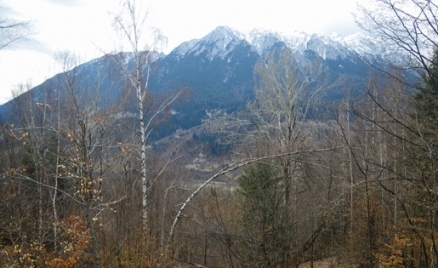Piatra Craiului National Park
Piatra Craiului National Park is a protected area situated in the eastern zone of the southern Carpathian Mountains in the Transylvanian region of Romania. This park is part of the ancestral homeland of Vlad the Impaler, inspiration of the legendary Dracula of folk history. These mountains were an element of the fifteenth century defensive landscape of Vlad the Impaler, whose real life efforts succeeded in defending the Romanian homeland from the 15th century Ottoman invasions. The National Park is generally generally synomymous in extent with the Piatra Craiuliu Mountain Range. Virtually all of the Park consists of a massif comprised of Mesozoic limestone. This protected area is within the Romanian ecoregion known as the Carpathian Montane Forests.
Contents
Location and access
The Park is bounded by the Damboviciora Valley on the east; the Barsa Valley to the north; and the River Dambovita to the west. This protected area stretches over parts of two Romanian counties: Brasov and Arges; moreover, the villages of Pestera and Magura are contained within the Park boundaries. The most common access road is an unpaved approach leading from the town of Zanesti to the northern end of Piatra Craiului; there is a lesser used access road at the southern end of the Park.
Geology and hydrology
The spine of the mountain range generally runs in a northeast-southwest direction, with crystalline bedrock occurring only on the western flanks of the Park. The highest peak with Piatra Craiului is V.f. Piscul Baciului with a summit of 2238 metres. The relatively high density limestone that prevails throughout the range is actually quite permeable, encouraging water retention and gradual release of streamflows. In actuality most of the streams draining the mountain flanks appear relatively dry throughout most of the year; exceptions to this observation include the watercourses of the very highest flow rates and the occurrences at peak flow subsequent to heavy storms and spring snowmelt. Another feature contributing to the apparent periodic desiccation of the streambeds is the presence of considerable limestone cobbles armouring many of the creeks. In these cases considerable subsurface flow occurs which is not visible as surface flow.
In addition to the boundary rivers set forth above, other principal watercourses draining the Piatra Craiului Range are Crapaturii River flowing north to the Barsa River; Curmaturii River draining much of the northeastern slopes before discharging to the Prapastiilot River, which in turn also flows into the Barsa; and the Coja River, which forms much of the watershed of the eastern slopes.
Climate
Along the main ridge the average annual temperature is zero degrees Celsius, which fact explains the presistent snow caps that decorate the upper elevations of the Park. At lower elevations the average annual temperature is about eight degrees Celsius. Prevailing winds are from the northeast off of the Transylvanian Plateau, although seasonal variations exist in this pattern. The wind velocities attain quite high levels at the upper slopes, producing wind pruning and flag shaped tree specimens at those greater elevations. Precipitation increases with higher altitudes on these mountains, with the peak amounts attaining as much as 1200 millimetres per annum.
Flora and fauna
Plant communities are stratified by elevation, with the alpine tree-line dominated by Cembran Pine. The sub-alpine zone is Norway Spruce dominant in a boreal forest habitat, having certain dwarf pines represented in the understory. The lowest elevation belt consists of a mixed beech and conifer woodland with patches of grassland. In general all of the forests are rather robust, and have been stewarded in a reasonably good manner of conservation; much of this outcome is due to the low human population in the region and the severe slopes characterising much of the mountain range.
In total, 1108 plant species have been identified in the Piatra Craiului Mountains, two of which, Ligularia siberica and Liparis loeselli, are local endemics. Other species endemic to the Carpathian Mountains as a whole are: Thesium kerneranium, Primula wulfeniana ssp. baumgarteniana (found only here and in Postavarul), Koeleria macrantha ssp. transsilvanica, Hesperis matronalis ssp. matronis, and Papaver alpinum sspcorana-sancti-stephani. There are also a number of other protected species present in the Park.
Chief apex predators are gray wolves and brown bears, the latter species manifesting an unusual hazel colour in the Piatra Craiului Range.[1] Other notable mammals include red and roe deer and mountain goats. There is a considerable variety of birdlife present including raptors and passerines.
References
Citation
Hogan, C. (2011). Piatra Craiului National Park. Retrieved from http://editors.eol.org/eoearth/wiki/Piatra_Craiului_National_Park- ↑ Laura Riley and William Riley. 2005. Nature's strongholds: the world's great wildlife reserves. Princeton University Press, Princeton, New Jersey
